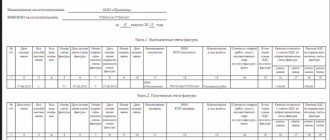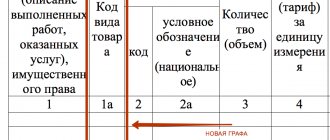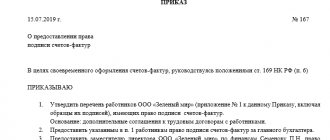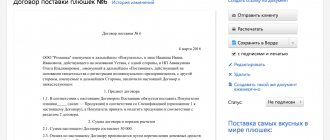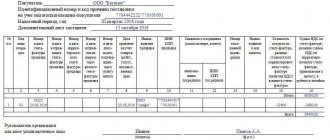What it is?
According to Art. 169 of the Tax Code of the Russian Federation, an invoice is a document that serves as the basis for the buyer to accept tax amounts for deduction from the seller of goods, services, work, or property rights.
The invoice is issued in electronic or paper form: in the first case, both parties to the transaction must have compatible technical means and capabilities to receive and process invoices.
If, after drawing up the document, inaccuracies were revealed in it, namely: there was a change in the cost of services performed, goods shipped or their volume, quantity downward, then the seller issues an adjustment invoice to the buyer (in accordance with Federal Law No. 245-FZ dated July 19, 2011 .).
The adjustment document helps to make a recalculation taking into account errors and inaccuracies that were made in previous years.
IMPORTANT! Invoices are required to be issued by those selling companies that are VAT payers.
Therefore, the objectives of this document are:
- confirmation of the completion of work or delivery of goods;
- confirmation of the amount of VAT paid with the possibility of its further offset.
Should the invoice indicate the contract number?
The absence of references to the agreement in the invoice is not a violation of the Resolution of the Federal Antimonopoly Service of the Moscow District dated November 22, 2010 N KA-A40/13902-10 in case No. A40-168846/09-99-1340 The court indicated that the absence of the agreement number in the invoices indicating its date and the name of the work performed does not deprive these documents of evidential value. The contract number is not a necessary detail of the invoice: Art.
9 of the Federal Law “On Accounting” does not provide for the mandatory indication of the contract number in the primary document. Resolution of the Federal Antimonopoly Service of the Volga District dated May 29, 2008 in case No. A55-13934/2007 The court indicated that clause 5 of Art. 169 of the Tax Code of the Russian Federation does not provide for the obligation to indicate a reference to the contract in invoices. Similar conclusions are contained...
Translation of VAT returns to electronic format, No. 21
- VAT: registration of advances in retail, No. 19
- Advance VAT: accrue, deduct, restore, No. 18
- Should tax authorities reduce VAT arrears for undeclared deductions, No. 17
- I want to know everything: we accept input VAT for deduction, No. 15
- Are you building for yourself? Don't forget about VAT, No. 13
- Clarification as an obstacle to a quick VAT refund, No. 12
- I want to know everything: VAT test, No. 11
- And again about invoices and purchase books, No. 11
- OSNO UTII turned into OSNO after purchasing OS: how to take into account expenses and VAT, No. 10
- We sell property registered with VAT, No. 9
- They didn’t recognize their tax expenses: is it necessary to charge VAT “for your own needs”?, No. 2
- The advance was transferred to another agreement: what to do with VAT, No. 2
- The buyer paid an extra advance: what about VAT, No. 2
- 2012
There are court decisions in which the courts, based on Decree of the Government of the Russian Federation of December 2, 2000 N 914, recognized the right to deduction for invoices with defects caused by technical errors. At the same time, the courts drew attention to the fact that these violations were eliminated by making corrections to the invoices, and also to the fact that the payment of VAT on the disputed invoices was confirmed.
At the same time, there are judicial acts in which the courts, citing Resolution of the Government of the Russian Federation No. 914, indicated that an invoice filled out with technical errors is not a basis for applying a deduction. For more details, see: Thus, the courts recognized as legal the deduction of VAT, confirmed by Resolution of the Federal Antimonopoly Service of April 23, 2009 No. A55-9765/2008; FAS North Caucasus Region dated June 25, 2010 No. A53-24161/2009:
- invoice, which indicates only the type);
- the agreement on the basis of which these services are provided and which contains a list of services provided;
- an act of acceptance and transfer of services, which contains only a reference to the contract for the provision of services;
- a report from the contractor with a detailed description of all services provided.
We invite you to familiarize yourself with: Social insurance payments
What is the basic form approved by the government?
An invoice is a document of a strictly established format. The form of the invoice form is approved by Decree of the Government of the Russian Federation No. 1137 of December 26, 2011 “On the forms and rules for filling out (maintaining) documents used in calculations of value added tax,” developed in accordance with the Tax Code of the Russian Federation.
In 2021, two editions of this Resolution have already been published: No. 625 of May 25, 2017 and No. 981 of August 19, 2017, according to which the form of the form was modified.
Decree of the Government of the Russian Federation No. 1137 approves the rules for filling out:
- Invoice used for VAT calculations.
- Adjustment invoice used for VAT calculations.
- Logbook of received and issued invoices.
- Purchase books.
- Sales books.
Graphs that should be in the document
Each field of the completed invoice is checked by inspectors of the Federal Tax Service during on-site or counter inspections.
ATTENTION! The details of this document must be filled out correctly, otherwise the invoice will be sent for revision or there is a risk of denial of VAT deduction to the business entity.
If there are gross errors indicating distorted facts of economic activity, the organization may be subject to penalties.
The form of each invoice consists of lines and columns with numbering and letter designation.
For sale
The sales document uses the following lines:
- 1 indicating the serial number and date of preparation of the document. The number is assigned in individual chronological order, and if the organization has a separate division that sells goods (services, property rights), the dividing line “/” is used (more information about the rules for filling out the document by separate divisions can be found here).
- 1a is used to indicate the serial number and date of amendment to the document. Before any corrections are made, a dash is placed on this line.
- 2 – indicate the name of the seller (legal entity, full name of individual entrepreneur).
- 2a – the address of the seller is indicated - a legal entity in accordance with the Unified State Register of Legal Entities or an individual entrepreneur in accordance with the entry in the Unified State Register of Individual Entrepreneurs.
- 2b – the taxpayer’s TIN, as well as the taxpayer’s checkpoint, are filled in.
- 3 – full or abbreviated name of the shipper. If the seller and the consignor coincide, the line is filled in with the words “he”; when performing work (services), a dash is added.
- 4 – full or abbreviated name of the consignee (as in the constituent documents), his address.
- 5 – details of the payment order or cash receipt are indicated if an advance payment was received from the buyer.
REFERENCE. If the invoice is issued on the day the advance payment is received, a dash is placed in line 4. - 6 – full or abbreviated name of the buyer, which is indicated in the constituent documents.
- 6a – the buyer’s address is indicated in accordance with the Unified State Register of Legal Entities or Unified State Register of Individual Entrepreneurs (until 01.10.2017, the address had to be indicated as in the constituent documents).
- 6b – the TIN, as well as the buyer’s checkpoint, are indicated.
- 7 – enter the name of the currency and its code in accordance with the All-Russian Classifier of Currencies (read about whether it is possible to issue an invoice in the currency of another country, where to find out and display such a code here).
- 8 – indicates the identification number of the state contract for the supply of goods, works, services or an agreement to provide subsidies to a legal entity from the federal budget in accordance with ed. Decree of the Government of the Russian Federation No. 625 of May 25, 2017. If the organization does not have such contracts, a dash is placed in line 8.
The following fields are used in the sales invoice:
- 1 with the name of the product or service supplied.
- 1a – the code of the type of product is indicated in accordance with the unified Commodity Nomenclature of Foreign Economic Activity of the EEC. If the organization does not export goods outside the Russian Federation, a dash is placed in the column.
- 2 and 2a – the code and symbol of the unit of measurement are indicated in accordance with OKEI. If they are not there, a dash is added.
- 3 – quantity of goods shipped or a dash.
- 4 – price per unit of goods or tariff for services provided excluding VAT; if there is no indicator, a dash is placed.
- 5 – indicates the cost of the entire volume of services provided or quantity of goods without VAT.
- 6 – the amount of excise tax is indicated; if a non-excise product is sold, the entry “Without excise tax” is entered.
- 7 – tax rate is indicated. If goods are sold without VAT, a corresponding entry is made (clause 5 of Article 168 of the Tax Code of the Russian Federation).
- 8 – the amount of VAT charged to the buyer, based on the tax rate.
- 9 – the cost of the total quantity of goods shipped or services provided, including VAT, is entered.
- 10 and 10a - for goods produced outside the Russian Federation, the code and name of the country of origin of the product are indicated.
- 11 – an entry is made with the registration number of the customs declaration for goods released outside the Russian Federation.
From separate publications by our experts, you can also learn about the timing of issuing an invoice to the buyer, as well as the rules for filling out the document when returning goods to the supplier and when providing services.
Corrective
IMPORTANT! The adjustment invoice has details similar to the document for the release of goods, but the filling of some of them is different.
The form contains the following lines:
- 1 – number in general chronological order and date of the document.
- 1a – number of the correction made and its date.
- 1b – number and date of the document (or several documents) for which the adjustment invoice is drawn up, as well as the date of their correction.
- lines 2, 2a and 2b are filled out in accordance with the information entered in the same lines of the invoice for which the adjustment document is being drawn up.
- lines 3, 3a and 3b contain information about the name, location, tax identification number and checkpoint of the buyer.
- 4 – name and code of the currency.
- 5 – identifier of a government contract or agreement.
Column 1 of the adjustment document is filled out in accordance with the name of the goods, works, services indicated in the same column in the invoice for the adjustment. Column 1b is filled in with the code of the type of product according to the unified Commodity Nomenclature for Foreign Economic Activity of the EEC.
REFERENCE. The adjustment document contains information about the quantity and (or) price of goods or services, both original and changed.
The information is indicated in the lines under the letter designations:
- A – before the change.
- B – after the change.
- B – increase.
- D – decrease (cost, quantity).
The final lines (there are two of them) indicate the sum of lines B or D. In addition, the document contains information about the change in the cost of goods supplied or services performed without VAT and with VAT, as well as the difference between the amount of taxes.
Advance
When reflecting the received advance payment, the same form of invoice was developed as for sale. The preparation of an advance invoice has several differences:
- Consignor and consignee data are missing.
- The details of the payment document for the advance payment must be indicated in the appropriate line.
- With 100% prepayment, the unit of measurement, quantity and price of the goods are indicated; with partial payment, these data are missing.
An advance invoice is drawn up if there is a rate for VAT calculation of 18% or 10%. If the product is not subject to VAT or the rate is 0%, this document is not drawn up.
You will find more information about the rules for filling out an advance invoice in our special material.
Name of taxpayer and buyer
From the provisions of paragraphs.
“c”, “and” clause 1 of the Rules it follows that lines 2 and 6 of the invoice indicate the full or abbreviated name of the legal entity. These provisions do not establish priority for the use of the full or abbreviated name. That is, invoices can indicate either the full or abbreviated name. Since neither the norms of the Tax Code of the Russian Federation nor Resolution No. 1137 disclose the concept of “name” of a legal entity, then on the basis of clause 1 of Art. 11 of the Tax Code of the Russian Federation, let us turn to other regulations that decipher this concept. In paragraph 1 of Art. 54 of the Civil Code of the Russian Federation states that a legal entity has its own name, which contains an indication of its organizational and legal form. Each organization must have a full name and has the right to have an abbreviated name.
In addition, a legal entity that is a commercial organization must have a company name (Clause 4, Article 54 of the Civil Code of the Russian Federation). A legal entity also has the right to have an abbreviated company name in Russian (clause 3 of Article 1473 of the Civil Code of the Russian Federation).
As a general rule, the full and (if available) abbreviated name, corporate name for commercial organizations in Russian is indicated in the constituent documents and the Unified State Register of Legal Entities (clause 5 of article 54 of the Civil Code of the Russian Federation, subsection “a”, clause 1 of article 5 Federal Law of 08.08.2001 N 129-FZ “On state registration of legal entities and individual entrepreneurs”).
The requirements for the corporate name of a joint-stock company are enshrined in Art. 4 of the Federal Law of December 26, 1995 N 208-FZ “On Joint-Stock Companies” (hereinafter referred to as Law N 208-FZ). According to this norm, the full corporate name of the company in Russian must contain the full name of the company and an indication of its organizational and legal form - joint stock company, and the full corporate name of the public company in Russian must also indicate that the company is public.
The abbreviated corporate name of a company in Russian must contain the full or abbreviated name of the company and the words “joint-stock company” or the abbreviation “AO”, and the abbreviated corporate name of a public company in Russian must contain the full or abbreviated name of the public company and the words “public joint-stock company” or abbreviation "PAO".
The corporate name of the company in Russian and in the languages of the peoples of the Russian Federation may contain foreign language borrowings in Russian transcription or in transcriptions of the languages of the peoples of the Russian Federation, with the exception of terms and abbreviations that reflect the organizational and legal form of the company.
Similar provisions on LLC brand names are contained in Art. 4 of Federal Law No. 14-FZ of 02/08/1998 “On Limited Liability Companies” (hereinafter referred to as Law No. 14-FZ).
Full and abbreviated (if any) company names of companies indicating the organizational and legal form must be contained in the constituent documents of the companies (paragraph 2, paragraph 3, article 11 of Law N 208-FZ, paragraph 2, paragraph 2, article 12 of Law N 14-FZ ).
As you can see, the abbreviations LLC, JSC, PJSC can only contain abbreviated company names of companies. At the same time, organizations have the right to have such names, but are not required to.
Therefore, if you follow the provisions of paragraphs. “c”, “and” clause 1 of the Rules, then if a legal entity does not have an abbreviated company name in lines 2 and 6 of the invoice in the name of such an organization, its organizational and legal form should be indicated, for example, as “Limited liability company " If the organization has an abbreviated corporate name, then it is permissible to indicate the corresponding abbreviation in the name.
At the same time, the norms of paragraphs. 2 p. 5, pp. 2 clause 5.1, paragraphs. 3 clause 5.2 art. 169 of the Tax Code of the Russian Federation only require the indication of the name of the seller and the buyer and do not indicate which name of the organization (full or abbreviated, full corporate name or abbreviated corporate name, with an abbreviation or not) should be indicated on the invoice.
At the same time, failure to comply with the requirements for the invoice not provided for in paragraphs. 5, 5.1, 5.2 and 6 art. 169 of the Tax Code of the Russian Federation cannot be a basis for refusing to accept for deduction the amounts of tax presented by the seller (paragraph 3 of clause 2 of Article 169 of the Tax Code of the Russian Federation). In addition, acts of executive authorities, including the Government of the Russian Federation, cannot change or supplement the legislation on taxes and fees, that is, the norms of the Tax Code of the Russian Federation in general and Chapter 21 of the Tax Code of the Russian Federation in particular, which is directly established by paragraph 1 of Art. 4 Tax Code of the Russian Federation.
In this regard, we will provide explanations from the financial and tax departments regarding taxpayers’ violation of the procedure for filling out line 2 in invoices issued in accordance with the requirements of the previously effective Decree of the Government of the Russian Federation dated December 2, 2000 N 914. At that time, in line 2 of the invoice in accordance with the provisions of the named Resolution it was necessary to indicate the full and abbreviated name of the seller in accordance with the constituent documents.
The authorized bodies explained that the norms of Art. 169 of the Tax Code of the Russian Federation, the procedure for indicating the full or abbreviated name of the taxpayer in invoices is not regulated, therefore, indicating in line 2 of invoices the full or abbreviated name of the seller in accordance with the constituent documents is not a reason for refusing to deduct the VAT amounts indicated in such invoices - invoices (letter from the Ministry of Finance of Russia dated July 7, 2009 N 03-07-09/32, Federal Tax Service of Russia for Moscow dated November 25, 2009 N 16-15/123937).
We invite you to read: Maternity leave under an employment contract without a work book
Note that we have not encountered any arbitration practice where a dispute about the legality of deducting VAT was considered based on invoices that indicate the abbreviation of the legal form of the buyer or seller, which may indicate the absence of claims from inspectors on this issue .
Indicating in the invoice an abbreviation of the legal form in the name of the seller and (or) buyer instead of its full spelling, in our opinion, cannot serve as an obstacle to identifying the seller and (or) buyer. Therefore, such an error (if recognized as such) is not a basis for refusing to accept VAT amounts for deduction (paragraph 2, clause 2, article 169 of the Tax Code of the Russian Federation).
Provisions of paragraphs. 2 p. 5, pp. 2 clause 5.1, paragraphs. 3 clause 5.2 art. 169 of the Tax Code of the Russian Federation and paragraphs. “c”, “and” clause 1 of the Rules do not establish requirements for the case of letters (uppercase, lowercase) or font for the purpose of indicating the names of the seller and buyer in the invoice. These norms do not apply to the Unified State Register of Legal Entities either.
Which of them are required to be filled out?
REFERENCE. Invoice details can be divided into mandatory ones, an error in which may lead to refusal to deduct VAT, and those, errors in filling in which do not imply refusal to deduct VAT.
Mandatory details, errors in which are “dangerous”:
- those that help identify both parties to the transaction as taxpayers: name, full name. seller and buyer;
- legal address of both parties indicated in the constituent documents (indicating the actual address is an error);
- TIN and checkpoint of the parties;
- information about the sender and recipient of the cargo (if this is the same person, it must be marked “the same person”);
- manager's signature;
- volume and cost of goods supplied;
- type of product and tax rate;
- details of the payment document for prepayment.
The above details are required to be filled out , but if they contain inaccuracies, the Federal Tax Service may accept VAT as a deduction if the errors do not interfere with identifying the parties to the transaction, as well as the name of the goods, works (services), their cost, tax rate and the amount of VAT.
Some details are considered additional (they are regulated by Chapter 21 of the Tax Code of the Russian Federation). These include: the unit of measurement of the product, which may be missing, as well as additional information that is necessary for the parties to the transaction and is indicated at the request of the seller.
Mandatory invoice details
Tax Code of the Russian Federation errors in invoices and adjustment invoices that do not prevent tax authorities from identifying the seller, buyer of goods (work, services), property rights, the name of the goods (work, services), property rights, their value, as well as tax rate are not grounds for refusing to accept VAT amounts for deduction. There are two points of view on this issue. There is no official position.
For more details, see the documents Position 1.
The absence of references to the contract in the invoice is a violation of the Resolution of the Federal Antimonopoly Service of the North-Western District dated September 26, 2011 in case No. A13-5629/2010. According to the court, it cannot be concluded that the invoices are directly related to the performance of work under the contract subcontracting. Invoices only contain references to acts of acceptance and transfer of services, but these acts also do not contain references to the contract.
Resolution of the Federal Antimonopoly Service of the North Caucasus District dated 08/05/2011 in case No. A53-20949/2010 The court indicated that the submitted invoices do not comply with the requirements of paragraphs. 5 p. 5 art. 169 of the Tax Code of the Russian Federation, since they do not include references to the agreement. This, according to the court, makes it impossible to verify the actual performance of services. Is it a violation of clauses 5 and 6 of Art. Controversial Issues on VAT, No. 11
- Correcting VAT errors, No. 11
- Filling out an invoice by an entrepreneur if he does not have a state registration certificate, No. 11
- Did the seller forget about VAT? Remind, you can’t remain silent!, No. 9
- Following the VAT return, No. 8
- About explanations for the VAT return and more..., No. 8
- Clarification on VAT: is it worth submitting after cameral, No. 7
- Transfer of advance debt: VAT difficulties for the buyer, No. 6
- We are preparing to submit the VAT return, No. 6
- Updated VAT return, No. 6
- Is the return of a compensation loan subject to VAT, No. 5
- Should I pay VAT when transferring lunches to employees?, No. 4
- Invoice for a set of imported goods, No. 3
- VAT changes, No. 1
- Who will pay VAT on foreign Internet services, No. 1
- To the VAT return - electronic explanations, No. 1
- 2016
We suggest you read: Cancellation of a real estate purchase and sale agreement
Is it possible to delete or add new rows?
In accordance with clause 9 of Government Decree No. 1137 of the Russian Federation, the taxpayer has the right to enter additional information in additional columns and lines of the invoice, but when adding, the regulated form of the document must be preserved .
IMPORTANT! To prevent the Federal Tax Service from refusing a deduction in the event of a tax audit, it is safest not to add the necessary information between the lines and columns of the required details.
This may cause controversy. Columns and lines with mandatory information cannot be deleted.
